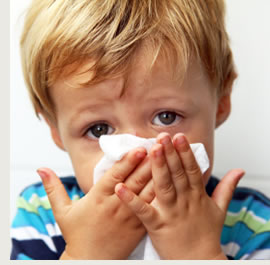|
|
|||||
|
|||||
| Strategies for success: colds and 'flu | |||||
|
While child care services may never be able to eradicate colds and 'flu completely there are a number of steps which can reduce their spread. This article will hopefully serve as a reminder of the best ways to keep the dreaded lurgy at bay. CONTROLLING INFECTION Infection control requires child care services to break the four step cycle of infection spread as described below:
The most effective ways of breaking this cycle of infection are to encourage regular hand washing by staff and children, to exclude staff and children from the service when they are sick and to promote immunisation. If these measures aren't followed then many of the other processes which support infection control, such as cleaning and food safety procedures will not work so well. HAND WASHING The best way to control the spread of infection in a child care service is to encourage regular and effective hand washing and drying by staff and children. The best way to promote hand washing is to ensure hand basins are readily accessible and located where they are most needed, for example near toilets, nappy change areas, food preparation areas and outdoors. Hand basins the right size and height for staff and children need to be available and providing soap dispensers, hands free taps and paper towels should help promote regular washing. Babies also need their hands washed just as regularly and thoroughly as older children. The National Health and Medical Research Council (NHMRC) recommends the following method for hand washing in child care services. How to Wash Hands The process of thoroughly washing and rinsing your hands should take 10-15 seconds. This is about as long as it takes to sing 'Happy Birthday' twice.
Download a free NHMRC poster to remind staff and children how to wash their hands properly here. When staff should wash their hands:
When children should wash their hands
EXCLUSION POLICIES Excluding sick staff and children from the service plays a very important role in controlling the spread of infection. Most parents will appreciate a service's efforts to prevent and control the spread of infection. However exclusion policies can be difficult to enforce when parents put a lot of pressure on staff to allow the children to attend child care even when they are sick. The best way to avoid conflict is to have a written policy that clearly states the service's exclusion criteria. A copy of this policy should be on public display and given to all parents as they enrol their child in the service. The need for exclusion should depend on; the ease with which the infection can be spread, the ability of the infected person to follow hygiene procedures and the severity of the disease. Refer to the NHMRC's guidelines provided at the end of this article for advice on recommended exclusion periods. IMMUNISATION Universal childhood immunisation is the third prong in the battle against infection and Is the most effective way of preventing certain common infections. Parents should be asked to provide a copy of their child's immunisation records on enrolment at the service and the parents of children who are not immunised should be advised that their children may be excluded from care during outbreaks of certain infectious diseases such as measles and whooping cough even if the child is well. The NHMRC recommends vaccination for all children and suggests that child care providers play an active role in encouraging parents to have their children vaccinated. Ways to encourage parents to vaccinate and keep their vaccinations up-to-date include:
Infection control relies on the consistent application of the above range of fairly straightforward measures. By working to ensure staff and children at your service are informed about your policies and procedures you'll hopefully keep this year's ‘flu season a short one! FURTHER READING |
|||||
|
|||||||||

 Most children, whether in care or not, sport a runny nose at this time of year and most educators spend the whole day with a tissue in hand ready to catch the never ending drips.
Most children, whether in care or not, sport a runny nose at this time of year and most educators spend the whole day with a tissue in hand ready to catch the never ending drips.